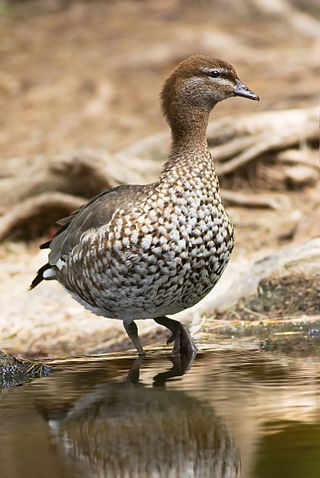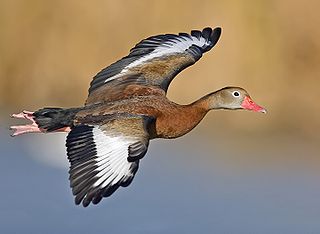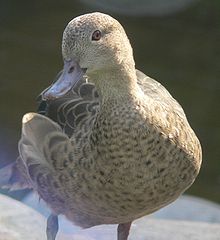
Duck is the common name for numerous species of waterfowl in the family Anatidae. Ducks are generally smaller and shorter-necked than swans and geese, which are members of the same family. Divided among several subfamilies, they are a form taxon; they do not represent a monophyletic group, since swans and geese are not considered ducks. Ducks are mostly aquatic birds, and may be found in both fresh water and sea water.

The gadwall is a common and widespread dabbling duck in the family Anatidae.

The mallard or wild duck is a dabbling duck that breeds throughout the temperate and subtropical Americas, Eurasia, and North Africa. It has been introduced to New Zealand, Australia, Peru, Brazil, Uruguay, Argentina, Chile, Colombia, the Falkland Islands, and South Africa. This duck belongs to the subfamily Anatinae of the waterfowl family Anatidae. Males have green heads, while the females have mainly brown-speckled plumage. Both sexes have an area of white-bordered black or iridescent purple or blue feathers called a speculum on their wings; males especially tend to have blue speculum feathers. The mallard is 50–65 cm (20–26 in) long, of which the body makes up around two-thirds the length. The wingspan is 81–98 cm (32–39 in) and the bill is 4.4 to 6.1 cm long. It is often slightly heavier than most other dabbling ducks, weighing 0.7–1.6 kg (1.5–3.5 lb). Mallards live in wetlands, eat water plants and small animals, and are social animals preferring to congregate in groups or flocks of varying sizes.

The Eurasian teal, common teal, or Eurasian green-winged teal is a common and widespread duck that breeds in temperate Eurosiberia and migrates south in winter. The Eurasian teal is often called simply the teal due to being the only one of these small dabbling ducks in much of its range. The bird gives its name to the blue-green colour teal.

The American teal or green-winged teal is a common and widespread duck that breeds in the northern areas of North America except on the Aleutian Islands. It was considered conspecific with the Eurasian teal for some time, but has since been split into its own species. The American Ornithological Society continues to debate this determination; however, nearly all other authorities consider it distinct based on behavioral, morphological, and molecular evidence. The scientific name is from Latin Anas, "duck" and carolinensis, "of Carolina".

The blue-winged teal is a species of bird in the duck, goose, and swan family Anatidae. One of the smaller members of the dabbling duck group, it occurs in North America, where it breeds from southern Alaska to Nova Scotia, and south to northern Texas. It winters along the Pacific and Atlantic coasts and south into the Caribbean islands and Central America.

The common pochard, known simply as pochard in the United Kingdom, is a medium-sized diving duck in the family Anatidae. It is widespread across the Palearctic. It breeds primarily in the steppe regions of Scandinavia and Siberia, and winters further south and west.

The Laysan duck, also known as the Laysan teal, is a dabbling duck endemic to the Hawaiian Islands. Fossil evidence reveals that Laysan ducks once lived across the entire archipelago, but today survive only on Laysan Island and two atolls. The duck has several physical and behavioral traits linked to the absence of ground-based predators in its habitat. By 1860, the ducks had disappeared from everywhere except Laysan Island. The introduction of European rabbits by guano miners at the end of the 19th century brought the bird to the brink of extinction in 1912, with twelve surviving individuals. Rabbits were eradicated from the island in 1923 and numbers of Laysan ducks began to rise, reaching 500 by the 1950s. In an effort to ensure the long-term future of this duck, 42 birds were translocated to Midway Atoll National Wildlife Refuge in 2002. These thrived in their new surroundings, and another group were later relocated to Kure Atoll.

The grey teal is a dabbling duck found in open wetlands in Australia and New Zealand.

The fulvous whistling duck or fulvous tree duck is a species of whistling duck that breeds across the world's tropical regions in much of Mexico and South America, the West Indies, the southern United States, sub-Saharan Africa and the Indian subcontinent. It has plumage that is mainly reddish brown, long legs and a long grey bill, and shows a distinctive white band across its black tail in flight. Like other members of its ancient lineage, it has a whistling call which is given in flight or on the ground. Its preferred habitat consists of wetlands with plentiful vegetation, including shallow lakes and paddy fields. The nest, built from plant material and unlined, is placed among dense vegetation or in a tree hole. The typical clutch is around ten whitish eggs. The breeding adults, which pair for life, take turns to incubate, and the eggs hatch in 24–29 days. The downy grey ducklings leave the nest within a day or so of hatching, but the parents continue to protect them until they fledge around nine weeks later.

The chestnut teal is a dabbling duck found in Australia. It is protected under the National Parks and Wildlife Act 1974.

The Australian wood duck, maned duck or maned goose is a dabbling duck found throughout much of Australia. It is the only living species in the genus Chenonetta. Traditionally placed in the subfamily Anatinae, it might belong to the subfamily Tadorninae (shelducks); the ringed teal may be its closest living relative.

The Pacific black duck is a dabbling duck found in much of Indonesia, New Guinea, Australia, New Zealand, and many islands in the southwestern Pacific, reaching to the Caroline Islands in the north and French Polynesia in the east. It is usually called the grey duck in New Zealand, where it is also known by its Maori name, pārera.

The whistling ducks or tree ducks are a subfamily, Dendrocygninae, of the duck, goose and swan family of birds, Anatidae. In other taxonomic schemes, they are considered a separate family, Dendrocygnidae. Some taxonomists list only one genus, Dendrocygna, which contains eight living species, and one undescribed extinct species from Aitutaki of the Cook Islands, but other taxonomists also list the white-backed duck under the subfamily.

The brown teal is a species of dabbling duck of the genus Anas native to New Zealand. For many years it had been considered to be conspecific with the flightless Auckland and Campbell teals in Anas aucklandica; the name "brown teal" has also been largely applied to that entire taxon. Common in the early years of European colonisation, the "brown duck" was heavily harvested as a food source. Its numbers quickly fell, especially in the South Island, and in 1921 they became fully protected. Captive breeding and releasing into predator-controlled areas has seen good localised populations re-introduced around the country in recent years.

The blue-billed teal, spotted teal or Hottentot teal is a species of dabbling duck of the genus Spatula. It is migratory resident in eastern and southern Africa, from Sudan and Ethiopia west to Niger and Nigeria and south to South Africa and Namibia. In west Africa and Madagascar it is sedentary.

The Madagascar pochard or Madagascan pochard is an extremely rare diving duck of the genus Aythya. Thought to be extinct in the late 1990s, specimens of the species were rediscovered at Lake Matsaborimena near Bemanevika in Madagascar in 2006. By 2017, a captive breeding program had produced a population of around 90 individuals. The birds were reintroduced to the wild in December 2018.

The New Zealand scaup, also known as the black teal or pāpango in Māori, is a diving duck species of the genus Aythya endemic to New Zealand. They weigh around 650 grams (23 oz) and measure around 40 centimetres (16 in), and have dark-coloured plumage. They are found throughout New Zealand in deep natural and man-made lakes and ponds.

The Andaman teal is a species of duck endemic to the Andaman archipelago in the Bay of Bengal. The species was formerly considered as a subspecies of the Sunda teal.

The South Georgia pintail, also misleadingly known as the South Georgian teal, is the nominate subspecies of the yellow-billed pintail, a duck in the dabbling duck subfamily Anatinae. It is endemic to the large (3,756 km2) subantarctic island of South Georgia and its accompanying archipelago, and is a vagrant to the South Sandwich Islands. It was among the birds noted by James Cook in January 1775, on the occasion of the first recorded landing on South Georgia, and was formerly considered a full species.























